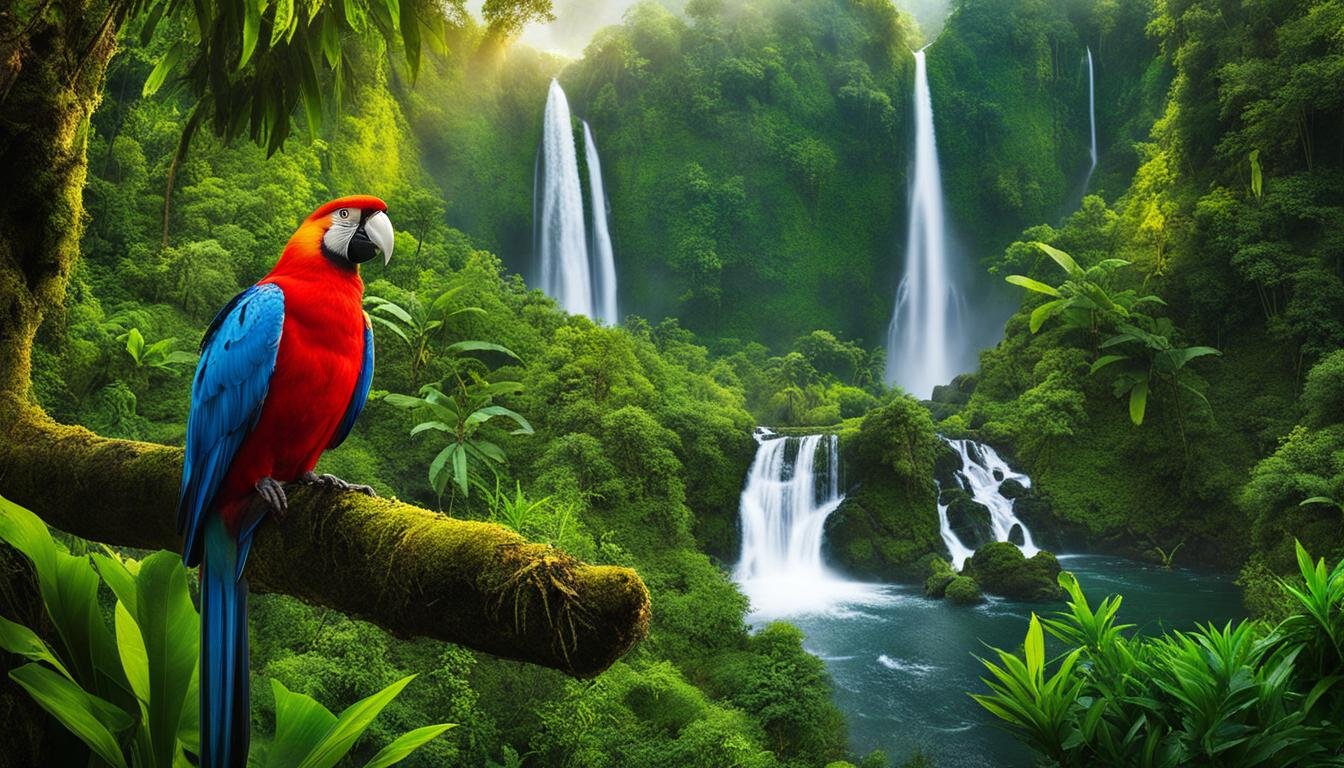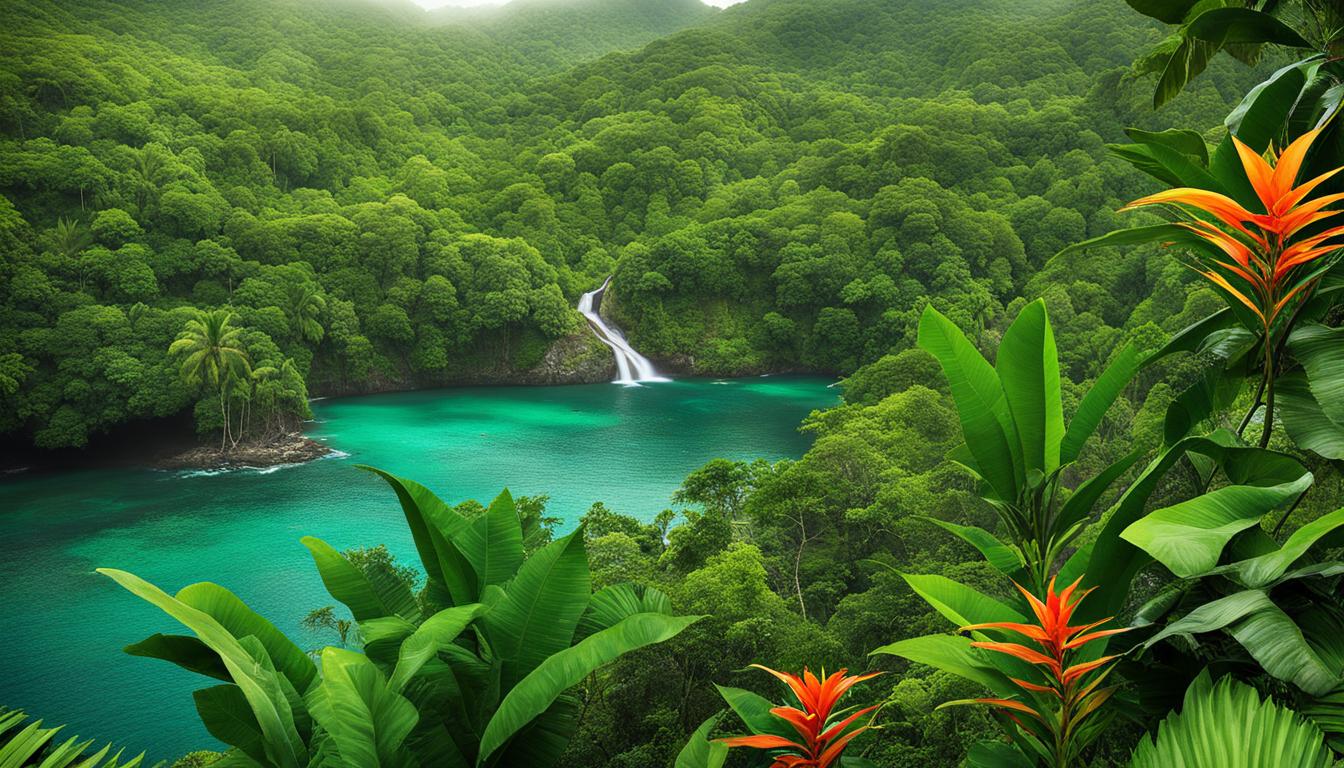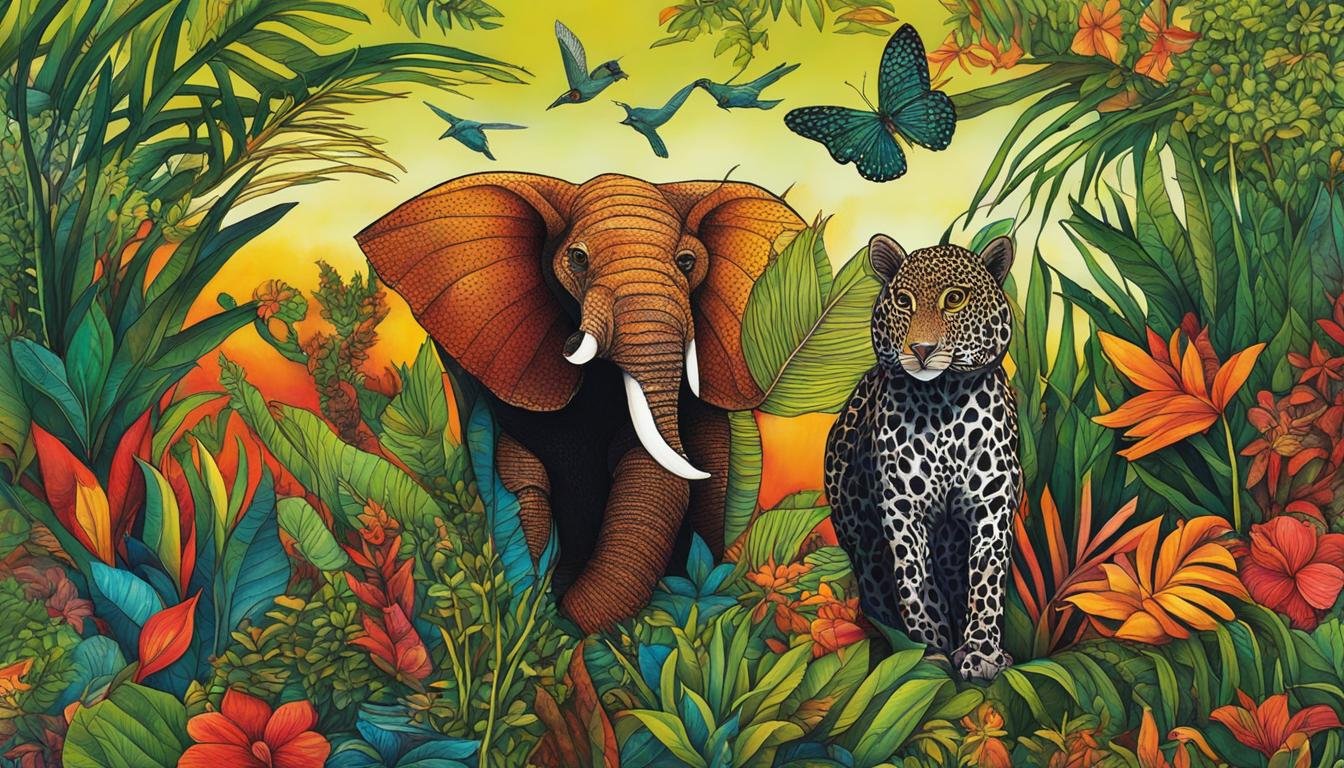Saint Kitts and Nevis Biodiversity: Animal and Plant Species and What Is Under Threat
Welcome to our article on the rich biodiversity of Saint Kitts and Nevis. This beautiful Caribbean nation is home to a diverse array of animal and plant species, making it a haven for flora and fauna enthusiasts. However, this unique ecosystem faces various threats that put its biological diversity at risk. Let’s dive deeper into the fascinating world of Saint Kitts and Nevis biodiversity and explore the challenges it faces.
Key Takeaways
- Saint Kitts and Nevis is blessed with a rich and diverse range of animal and plant species.
- However, this biodiversity is under threat from various factors such as demographic changes, socioeconomic factors, and policy frameworks.
- Maintaining the ecological balance is crucial to safeguard the numerous benefits that biodiversity provides.
- Habitat loss, invasive species, climate change, and overexploitation pose specific threats to the unique biodiversity of Saint Kitts and Nevis.
- Conservation efforts, including setting national biodiversity targets and mainstreaming biodiversity into national development, are vital for preserving this valuable ecosystem.
Importance of Biodiversity at the National Level
The biodiversity of Saint Kitts and Nevis plays a crucial role in ensuring the ecological balance and conservation of flora and fauna at the national level. This rich biodiversity provides a wide range of essential ecosystem services that are vital for the sustainability and well-being of the country.
Biodiversity conservation is of utmost importance to protect and preserve the diverse array of plant and animal species found in Saint Kitts and Nevis. The preservation of these species is essential for the overall ecological balance and long-term health of the ecosystem.
One of the key aspects of biodiversity is its ability to provide various ecosystem services that are crucial for human well-being. The flora and fauna of Saint Kitts and Nevis contribute to the protection of water resources, nutrient storage and recycling, carbon sequestration, and drought mitigation.
The biological resources derived from biodiversity are invaluable to society. They include essential goods such as food, medicinal resources, wood products, and breeding stocks. These resources not only support local livelihoods but also contribute to national economic growth.
In addition to tangible benefits, biodiversity plays a significant role in providing intangible social benefits. Research and development in the field of biodiversity contribute to scientific advancements and enhance our understanding of the natural world. Education and monitoring programs promote environmental awareness and empower individuals to take proactive measures for sustainability.
Furthermore, biodiversity is a source of recreation and tourism, attracting visitors who appreciate the unique natural beauty and ecological richness of Saint Kitts and Nevis. The diverse flora and fauna offer opportunities for ecotourism, promoting local businesses and fostering cultural exchange.
Biodiversity is not just about the number of species; it is about the intricate web of interactions that sustain life on Earth.
Maintaining ecological balance is vital to ensure the sustainability of these benefits and the overall health of the ecosystem. The intricate web of interactions between different species helps in regulating population sizes, controlling pests, pollinating plants, and recycling nutrients. Disruptions to this balance can have far-reaching consequences for both the environment and human societies.
By recognizing the importance of biodiversity at the national level, Saint Kitts and Nevis can prioritize biodiversity conservation efforts and implement sustainable practices to protect its unique flora and fauna. This will not only preserve the natural heritage of the islands but also contribute to the global conservation of biological diversity.
Status and Trends of Biodiversity in Saint Kitts and Nevis
Saint Kitts and Nevis boast a remarkable wildlife diversity, with a wide array of flora and fauna. From endemic plant species to the captivating marine ecosystems, the islands offer a rich and vibrant natural environment. However, this biodiversity is facing significant threats that compromise its survival and ecological balance.
One of the primary challenges to biodiversity in Saint Kitts and Nevis is habitat loss. As human populations expand and urbanization encroaches on natural habitats, crucial ecosystems become fragmented, leading to the decline of many plant and animal species. Invasive species also pose a major threat to the delicate equilibrium of the islands’ biodiversity. These non-native species can outcompete native flora and fauna, disrupting the intricate web of life. Climate change is yet another threat, altering habitats and affecting the survival of vulnerable species.
Pollution, both from land-based activities and marine sources, further exacerbates the plight of biodiversity in Saint Kitts and Nevis. The introduction of harmful substances into the environment can have devastating consequences for marine life, affecting delicate coral reefs and the species that rely on them. Overexploitation of natural resources, such as overfishing, compounds the problem, compromising the sustainability of marine ecosystems.
To effectively protect the biodiversity of Saint Kitts and Nevis, it is crucial to understand its current status and trends. This knowledge enables the implementation of targeted conservation measures to mitigate the threats faced by wildlife and ecosystems. By studying the changes in plant and animal populations, researchers can identify areas of focus and tailor conservation strategies accordingly.

Specific Threats to Biodiversity in Saint Kitts and Nevis
Several factors pose specific threats to biodiversity in Saint Kitts and Nevis. The demographic changes, driven by population growth and urbanization, result in habitat destruction and fragmentation, endangering the delicate balance of ecosystems. Unsustainable agricultural practices and resource extraction due to socioeconomic factors further contribute to the negative impacts on biodiversity. Moreover, market-based factors such as the demand for specific species or products can lead to overexploitation, jeopardizing the survival of vulnerable species. Inadequate regulations and the development of built environments exacerbate the problem, causing habitat loss and destruction of crucial biodiversity-rich areas.
To visualize the specific threats to biodiversity in Saint Kitts and Nevis, the following table provides a comprehensive overview:
| Threats | Impact |
|---|---|
| Demographic changes (population growth and urbanization) | Habitat destruction and fragmentation |
| Socioeconomic factors (unsustainable agriculture and resource extraction) | Negative impacts on biodiversity |
| Market-based factors (demand for certain species or products) | Overexploitation of vulnerable species |
| Policy framework and built developments | Inadequate regulations and habitat destruction |
These threats highlight the urgent need for effective conservation measures to safeguard the unique biodiversity of Saint Kitts and Nevis for future generations.

Consequences of Biodiversity Changes
Biodiversity loss has far-reaching consequences for ecosystems and human well-being. When biodiversity is compromised, the functioning of ecosystems is disrupted, leading to a range of negative impacts. These consequences include reduced resilience, decreased productivity, and increased vulnerability to environmental changes.
Ecosystems rely on a complex web of interactions between species to maintain balance and stability. The loss of key species can disrupt this delicate equilibrium, causing a cascade of effects throughout the food chain. This disruption can have far-reaching consequences for the entire ecosystem, impacting the abundance and distribution of other species.
Image:

Additionally, biodiversity loss can have significant implications for human well-being. Ecosystems provide a wide range of goods and services, such as food, clean water, and climate regulation, which are crucial for human survival and development. When ecosystem functioning is compromised, these services may be compromised, affecting our quality of life and socio-economic systems.
It is essential to address and mitigate the consequences of biodiversity changes to maintain the health and stability of ecosystems. By prioritizing biodiversity conservation efforts, we can work towards restoring and preserving the intricate web of life that supports ecological balance and sustains both nature and society.
National Biodiversity Targets and Conservation Efforts
Saint Kitts and Nevis, known as a biodiversity hotspot, is committed to preserving its unique flora and fauna. To achieve this, the country has set national biodiversity targets aligned with the global “Aichi Targets” under the Convention on Biological Diversity’s Strategic Plan. These targets serve as a framework to guide conservation efforts and promote sustainable development.
Various initiatives have been implemented in Saint Kitts and Nevis to protect and preserve biodiversity. These efforts include:
- Poverty reduction programs that focus on sustainable livelihoods, reducing reliance on natural resources, and promoting alternative income-generating activities.
- Agricultural diversification projects that encourage the cultivation of a wide range of crops and promote sustainable farming practices.
- Environmental management strategies to mitigate the impacts of human activities on ecosystems and habitats.
- Water resources management plans to ensure the sustainable use of water and protect aquatic ecosystems.
- Land use planning initiatives that promote sustainable development and consider biodiversity conservation in decision-making processes.
- Biodiversity conservation programs aimed at protecting endangered species, preserving habitats, and promoting ecological restoration.
Through these efforts, Saint Kitts and Nevis aims to strike a balance between economic development and biodiversity conservation. By integrating conservation practices into various sectors, the country strives to achieve sustainable development while safeguarding its rich biodiversity.

Mainstreaming Biodiversity Conservation into National Development
Saint Kitts and Nevis recognizes the importance of integrating biodiversity conservation into national development plans and policies. The mainstreaming of biodiversity considerations across various sectors is crucial for ensuring that conservation efforts are prioritized and effectively integrated into decision-making processes. By doing so, the country can maximize the positive impact of biodiversity conservation on sustainable development.
Incorporating biodiversity into national development strategies can contribute to addressing key challenges and achieving multiple goals. For instance, mainstreaming biodiversity into poverty reduction efforts can help alleviate the impacts of biodiversity loss on vulnerable communities and promote sustainable livelihoods. By integrating biodiversity considerations into agricultural practices, the country can enhance ecosystem services such as pollination, pest control, and soil fertility, ultimately supporting food security and sustainable agricultural production.
Addressing land degradation is another important aspect of mainstreaming biodiversity conservation into national development. By implementing land use planning strategies that prioritize the preservation and sustainable management of natural habitats, Saint Kitts and Nevis can prevent further degradation and safeguard biodiversity-rich areas.
Integrated water resources management is essential for maintaining healthy aquatic ecosystems and ensuring a sustainable water supply for the country. By incorporating biodiversity conservation into water management policies and practices, Saint Kitts and Nevis can protect water resources and the species that rely on them.
Gender-responsive approaches play a crucial role in mainstreaming biodiversity conservation. By recognizing the different roles and contributions of men and women in biodiversity management, the country can promote equal participation and decision-making in conservation efforts.
Addressing climate change is another vital aspect of mainstreaming biodiversity conservation into national development. By integrating biodiversity considerations into climate change adaptation and mitigation strategies, Saint Kitts and Nevis can enhance ecosystem resilience, reduce greenhouse gas emissions, and contribute to global climate change goals.

Mainstreaming biodiversity conservation into national development requires a multi-sectoral approach and collaboration among government agencies, civil society organizations, and other stakeholders. Through effective mainstreaming, Saint Kitts and Nevis can ensure that biodiversity conservation is prioritized, leading to sustainable development and the preservation of its unique natural heritage.
Progress towards the Aichi Biodiversity Targets and Millennium Development Goals
Saint Kitts and Nevis has made commendable progress in achieving the Aichi Biodiversity Targets outlined in the Strategic Plan for Biodiversity 2011-2020. By aligning its efforts with these global targets, the country is actively contributing to the global agenda for biodiversity conservation and sustainable development.
Furthermore, the implementation of the Strategic Plan has also had a positive impact on the Millennium Development Goals, a set of global targets aimed at addressing poverty, hunger, education, gender equality, and environmental sustainability. Saint Kitts and Nevis’s commitment to biodiversity conservation directly supports the relevant goals and targets included in the Millennium Development Goals.
By integrating biodiversity conservation into its development strategies, Saint Kitts and Nevis strives to optimize the benefits derived from its unique flora and fauna. The country’s progress towards the Aichi Biodiversity Targets and Millennium Development Goals serves as a testament to its dedication to safeguarding its natural resources and achieving sustainable development.

| Aichi Biodiversity Targets | Millennium Development Goals | |
|---|---|---|
| Target 1: | Address the underlying causes of biodiversity loss by mainstreaming biodiversity across government and society. | Goal 1: Eradicate extreme poverty and hunger. |
| Target 2: | Reduce the direct pressures on biodiversity and promote sustainable use. | Goal 2: Achieve universal primary education. |
| Target 3: | Improve the status of biodiversity by safeguarding ecosystems, species, and genetic diversity. | Goal 3: Promote gender equality and empower women. |
| Target 4: | Enhance the benefits of biodiversity and ecosystem services for all. | Goal 4: Reduce child mortality. |
| Target 5: | Enhance implementation through participatory planning, knowledge management, and capacity-building. | Goal 5: Improve maternal health. |
| Target 6: Mobilize resources for biodiversity conservation and sustainable development. | Goal 7: Ensure environmental sustainability. | |
| Target 7: Enhance the implementation of the Convention on Biological Diversity through science, technology, and traditional knowledge. |
Challenges and Lessons Learned
Saint Kitts and Nevis faces various challenges in biodiversity conservation, including the need to improve biodiversity data coverage. This lack of comprehensive data hinders our understanding of the impacts of biodiversity loss and limits our ability to make informed decisions for conservation efforts.
To address these challenges, there is a crucial need for investment in research focused on biodiversity. Through scientific research, we can deepen our understanding of the intricate connections between species, ecosystems, and their functioning. This understanding will enable us to assess the state of biodiversity more accurately and identify effective conservation strategies.
“Investing in research is investing in the future of biodiversity conservation. It equips us with the knowledge needed to preserve the unique plant and animal species that make Saint Kitts and Nevis so precious.”
Additionally, providing guidance, training, and education to both experts and the general public is essential in promoting and achieving biodiversity conservation. Experts can benefit from specialized training and guidance that focuses on using robust methodologies for biodiversity assessment and monitoring. Simultaneously, educating the public about the importance of biodiversity and the consequences of its loss can help foster a sense of stewardship and encourage individuals to take actions that support conservation efforts.
Ultimately, by addressing challenges related to biodiversity data coverage, investing in research, and providing guidance, training, and education, we can collectively work towards a more sustainable future for Saint Kitts and Nevis, preserving its unique biodiversity for generations to come.
Mitigating the Impacts of Invasive Species
One of the specific challenges in Saint Kitts and Nevis is the impact of invasive species, such as the green monkey. These species pose threats to biodiversity and food security. Efforts are being made to develop action plans and management strategies to mitigate the impacts of invasive species on the ecosystem and agricultural production. These initiatives involve techniques like live trapping and the use of electric fencing to control the population of invasive species.

Building Capacity for Invasive Species Management
Effectively addressing the challenges posed by invasive species in Saint Kitts and Nevis requires building capacity for invasive species management. To achieve this, the Caribbean Invasive Species Trust Fund and the Caribbean Biosecurity Interceptions System have been established. These initiatives aim to provide the necessary financial resources, coordination, and strategic focus for effective invasive species management.
Investing in research, monitoring, and targeted interventions is crucial to control not only the green monkey but also other invasive species and feral animals that pose a threat to biodiversity. By implementing comprehensive management strategies, Saint Kitts and Nevis can safeguard its unique ecosystem and protect native flora and fauna.
Conclusion
Saint Kitts and Nevis, with its remarkable biodiversity, is a haven for numerous plant and animal species, establishing itself as a biodiversity hotspot. However, this precious ecosystem faces numerous threats, including habitat loss, invasive species, and the far-reaching effects of climate change. To combat these challenges, conservation efforts are of utmost importance. Saint Kitts and Nevis has taken significant strides towards protecting and preserving its unique ecosystem by setting national biodiversity targets and integrating biodiversity considerations into national development plans.
By promoting sustainable development practices and prioritizing ecological balance, Saint Kitts and Nevis is laying a solid foundation for the long-term viability of its diverse flora and fauna. Conservation initiatives, such as poverty reduction, agricultural diversification, and environmental management, serve as pillars in safeguarding the country’s rich biodiversity. Additionally, by mainstreaming biodiversity into decision-making processes across various sectors, Saint Kitts and Nevis is ensuring that the importance of conservation efforts is recognized at every level.
Through these collective conservation endeavors, Saint Kitts and Nevis aims to create lasting benefits for both its natural environment and its people. By preserving its biodiversity, the country not only maintains the intricate web of life but also protects essential ecosystem services like water resources, carbon sequestration, and food production. Furthermore, biodiversity conservation contributes to the well-being of the local communities by providing opportunities for research, education, recreation, and sustainable tourism.
The commitment to balancing development and biodiversity will secure a bright future for Saint Kitts and Nevis, where generations to come can continue to marvel at the wonders of its unique ecosystems. Through ongoing efforts, the country is paving the way for a harmonious coexistence between humans and nature, ensuring that the invaluable biodiversity of Saint Kitts and Nevis thrives for years to come.
FAQ
What is biodiversity?
Biodiversity refers to the variety of animal and plant species in a given area or ecosystem.
How important is biodiversity in Saint Kitts and Nevis?
Biodiversity in Saint Kitts and Nevis is crucial at the national level as it provides ecosystem services, biological resources, and social benefits necessary for the sustainability of the islands’ ecosystems and the well-being of its people.
What are the threats to biodiversity in Saint Kitts and Nevis?
The main threats to biodiversity in Saint Kitts and Nevis include habitat loss, invasive species, climate change, pollution, and overexploitation.
How do demographic changes affect biodiversity?
Demographic changes, such as population growth and urbanization, can lead to habitat destruction and fragmentation, negatively impacting biodiversity.
What are the socioeconomic factors that contribute to biodiversity loss?
Unsustainable agricultural practices and resource extraction are examples of socioeconomic factors that can have negative impacts on biodiversity in Saint Kitts and Nevis.
What is meant by mainstreaming biodiversity into national development?
Mainstreaming biodiversity into national development involves integrating biodiversity considerations into various sectors, such as poverty reduction, agriculture, land degradation, water resources management, gender, and climate change, to ensure biodiversity conservation is a priority in decision making.
What is being done to conserve biodiversity in Saint Kitts and Nevis?
Saint Kitts and Nevis has set national biodiversity targets and implemented conservation efforts focused on poverty reduction, agricultural diversification, environmental management, water resources management, land use planning, and biodiversity conservation.
How do invasive species impact biodiversity in Saint Kitts and Nevis?
Invasive species, such as the green monkey, pose threats to biodiversity and food security in Saint Kitts and Nevis by disrupting ecological balance and agricultural production.
What initiatives are in place for invasive species management?
Initiatives like the Caribbean Invasive Species Trust Fund and the Caribbean Biosecurity Interceptions System provide financial resources, coordination, and strategic focus on invasive species management in Saint Kitts and Nevis.
What are the challenges in biodiversity conservation in Saint Kitts and Nevis?
Challenges in biodiversity conservation include insufficient biodiversity data coverage, the need for research and assessments, and the importance of providing guidance, training, and education to promote awareness and conservation.








